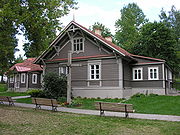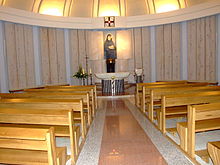- Mary Faustina Kowalska
-
Saint Mary Faustina Kowalska 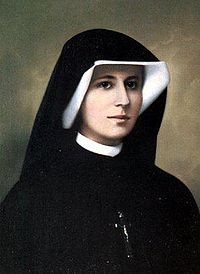
Saint Mary Faustina Kowalska of the Blessed SacramentVirgin, Apostle of Divine Mercy Born 25 August 1905
Głogowiec, Łęczyca County, Russian EmpireDied October 5, 1938 (aged 33)
Kraków, PolandHonored in Roman Catholic Church Beatified 18 April 1993 Canonized 30 April 2000, Pope John Paul II Major shrine Basilica of Divine Mercy, Kraków, Poland Feast 5 October Patronage World Youth Day Maria Faustina Kowalska, commonly known as Saint Faustina, born Helenka Kowalska (August 25, 1905, near Lodz, Poland then in the Russian Empire – Died October 5, 1938, Kraków, Poland)[1] was a Polish nun, mystic and visionary. She is venerated in the Roman Catholic Church as a saint, and is known as the Apostle of Divine Mercy.
Throughout her life, she reported a number of visions of Jesus and conversations with him, which she wrote about in her diary, later published as the book Diary: Divine Mercy in My Soul.[2] Her Vatican biography quotes some of these conversations regarding the Divine Mercy devotion.[3]
At age 20 she joined a convent in Warsaw and was later transferred to Plock, and then to Vilnius, where she met her confessor Michael Sopocko who supported her devotion to Divine Mercy. Faustina and Sopocko directed an artist to paint the first Divine Mercy image, based on Faustina's reported vision of Jesus. Sopocko used the image to celebrate the first Mass on the first Sunday after Easter - which later became known as Divine Mercy Sunday.[4]
In her diary Faustina predicted that her work would be suppressed for some time, then accepted again. Two decades after her death the Divine Mercy devotion was banned by the Vatican, but was approved again in 1978 and she was declared the first saint of the 21st century in April 2000.[5][2] The Divine Mercy devotion is now followed by over 100 million Catholics.[6]
Contents
Early life
Childhood and early years
She was born as Helenka Kowalska, in Głogowiec, Łęczyca County, just west of Lodz in Poland.[3][7][8] She was the third of ten children of Stanislaus and Marianna Kowalska. Stanislaus was a carpenter and a peasant, and the family was poor and religious.[9][3]
She stated that she first felt a calling to religious service while attending the Exposition of the Blessed Sacrament at age seven.[10] She wanted to enter the convent after finishing school, but her parents would not give her permission. When she was sixteen years old, she went to work as a housekeeper in Lodz to support herself and help her parents.[3][8] After a year of working, she twice asked her parents to let her enter a convent, but her requests were met with a firm refusal.
Joining the convent in Warsaw
In the summer of 1924, at age 19, Faustina and her sister Natalia went to a dance in a park in Lodz. Faustina stated that while at the dance she had a vision of a suffering Jesus, and rushed away to the church, where she was told by Jesus to leave for Warsaw immediately and join a convent.[11][8][7] She packed a small bag that night and took a train for Warsaw (130 miles away) the next morning, without the permission of her parents, and without knowing anyone in Warsaw.[11][7]
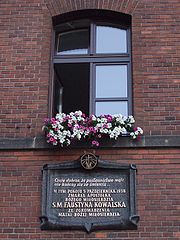 Plaque on the window of Faustina's convent room in Kraków-Łagiewniki
Plaque on the window of Faustina's convent room in Kraków-Łagiewniki
After she arrived in Warsaw, she entered the first church she saw, (St. James' church on Grojeka street) and attended Mass. She asked the priest, Father Dabrowski, for suggestions, and he recommended staying with Mrs Lipszycowa, a local lady whom he considered trustworthy, until she found a convent.[11][7]
Faustina approached several convents in Warsaw, but was turned down time after time, in one case she was told "we do not accept maids here", referring to her being penniless and without much education.[11] After several weeks of searching, eventually the Mother Superior at the convent of the Sisters of Our Lady of Mercy decided to give her a chance and conditionally accepted her, provided she could pay for her habit.[7][11]
Faustina knew nothing about the convent she was joining, except that she was led there.[12] But she knew that she had joined the convent as a "lay sister" and that due to her lack of education it was not likely she would attain higher levels within the order and that her duties would forever consist of cooking, cleaning and gardening.[12]
During 1925, Faustina worked as a house maid for one year to save up money, making deposits at the convent through the year and was then accepted at the convent. On April 30 1926, at age 20, she received her habit and took the name "Maria Faustina" of the Blessed Sacrament.[5][7][8] The name Faustina means the "fortunate or blessed one" and may have been a feminine form of the name of the Christian martyr Faustinus.[12] In April 1928 she took her first vows as a nun, and her parents attended the ceremony.[5] She was to be a nun for just over a decade, dying in October 1938.
From February to April 1929 she was sent to the convent in Vilnius, Lithuania as a cook.[5] Although this was a short stay in Vilnius, she would return there later and meet Father Sopocko who supported her mission. A year after her first return from Vilnius, in May 1930 she was transferred to the convent in Plock, Poland for close to two years.[5]
Life as a nun
Plock and the Divine Mercy image
See also: Divine Mercy image and Divine Mercy Sunday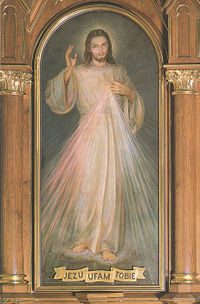 The Divine Mercy image painted by Adolf Hyla. The Polish inscription at the bottom means "Jesus I trust in you"
The Divine Mercy image painted by Adolf Hyla. The Polish inscription at the bottom means "Jesus I trust in you"
Faustina arrived in Plock in May 1930. In the autumn of that year the first signs of her illness (which was later thought to be tuberculosis) appeared and she was sent to rest for several months in a nearby farm owned by her religious order. After recovery she returned to the convent and by February 1931, had been in the Plock area for about nine months.[5]
Faustina wrote that on the night of Sunday February 22, 1931, while she was in her cell in Plock, Jesus appeared to her as the "King of Divine Mercy" wearing a white garment, with rays of white and red light emanating from near his heart.[13][14][2] In her diary (Notebook I, items 47 and 48) she wrote that Jesus told her:
"Paint an image according to the pattern you see, with the signature: "Jesus, I trust in You". I desire that this image be venerated, first in your chapel, and then throughout the world. I promise that the soul that will venerate this image will not perish."[15][13][15]
Not knowing how to paint, Faustina approached some other nuns at the convent in Plock for help, but received no assistance.[16][17] Three years later, after her assignment to Villnius, the first artistic rendering of the image was performed under her direction.
In the same February 22, 1931 message about the Divine Mercy image, Faustina also wrote in her diary (Notebook I, item 49) that Jesus told her that he wanted the Divine Mercy image to be "solemnly blessed on the first Sunday after Easter; that Sunday is to be the Feast of Mercy."[15][18]
In November 1932 Faustina returned to Warsaw to prepare to take her final vows as a nun.[5] On the first day of May 1933 she took her final vows in Lagiewniki and became a perpetual sister of Our Lady of Mercy.[5][19]
Vilnius: meeting Father Sopocko
See also: Chaplet of Divine MercyIn late May 1933 Faustina was transferred to Vilnius as the gardener - her job also included growing vegetables.[19] She remained in Vilnius for about 3 years, until March 1936. The convent in Vilnius had only 18 sisters at the time and consisted of a few scattered small houses, rather than a large building.[19]
A small convent house where Faustina lived in Vilnius
Shortly after arriving in Vilnius, Faustina met Father Michael Sopocko, the newly appointed confessor to the nuns. Sopocko was also a professor of pastoral theology at Stefan Batory University (now called Vilnius University).
When Faustina went to Sopocko for her first confession, she told him that she had been conversing with Jesus, who had a plan for her.[19] After some time, in fall 1933 Father Sopocko insisted on a complete psychiatric evaluation of Faustina by Dr. Helena Maciejewska, a psychiatrist and a physician associated with the convent. Faustina passed the required tests and was declared of sound mind.[19][20][21]
Thereafter, Sopocko began to have confidence in Faustina and supported her efforts. Sopocko also advised Faustina to begin writing a diary and to record the conversations and messages from Jesus which she was reporting.[19] Faustina told Sopocko about the Divine Mercy image and in January 1934 Sopocko introduced her to the artist Eugene Kazimierowski, who was also a professor at the university.[16][13][19]
By June 1934, Kazimierowski had finished painting the image based on the direction of Faustina and Father Sopocko.[22] That was the only Divine Mercy painting Faustina saw.[13] After Faustina's death, a number of other artists painted the image, with the depiction by Adolf Hyla being among the most reproduced.[23]
While she was in Vilnius, Faustina predicted that her message of Divine Mercy would be suppressed for some time, and appear to be "utterly undone" but that it would be accepted again.[2][24] On February 8, 1935, she wrote in her diary (Notebook I, item 378):
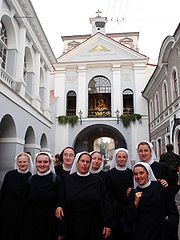 Novice Divine Mercy nuns in Vilnius, in front of the church of Gate of Dawn where the first Divine Mercy Sunday Mass was held in April 1935.
Novice Divine Mercy nuns in Vilnius, in front of the church of Gate of Dawn where the first Divine Mercy Sunday Mass was held in April 1935.
There will come a time when this work, which God is demanding so very much, will be as though utterly undone. And then God will act with great power, which will give evidence of its authenticity. It will be a new splendor for the Church, although it has been dormant in it from long ago.
Over twenty years later, in 1959, her messages were suppressed by the Vatican, but were accepted again in 1978.[5][2]
Faustina wrote in her diary (Notebook I item 414) that on Good Friday April 19, 1935 Jesus told her that he wanted the Divine Mercy image publicly honored.[5] On Friday April 26, 1935 Father Sopocko delivered the first sermon ever on the Divine Mercy - and Faustina attended the sermon.[22]
The first Mass during which the Divine Mercy image was displayed was on April 28, 1935, the second Sunday after Easter and was attended by Faustina.[4] April 28 1935 was also the celebration of the end of the Jubilee of the Redemption by Pope Pius XI.[4][25] However, Father Michael Sopocko (Faustina's confessor) managed to obtained Archbishop Jałbrzykowski's permission to place the Divine Mercy image within the Gate of Dawn church in Vilnius during the Mass that Sunday and celebrated the Mass himself.[4][22]
On September 13, 1935, while still in Vilnius, Faustina wrote of a vision about the Chaplet of Divine Mercy in her diary (Notebook I item 476).[26][27] The chaplet is about a third of the length of the Rosary.[27] Faustina wrote that the purpose for chaplet's prayers for mercy are threefold: to obtain mercy, to trust in Christ's mercy, and to show mercy to others.[28][2]
In November 1935 Faustina wrote the rules for a new contemplative religious congregation devoted to Divine Mercy, and in December she visited a house in Vilnius which she said she had seen in a vision as the first convent for the congregation.[5]
In January 1936 Faustina went to see Archbishop Jałbrzykowski to discuss a new congregation for Divine Mercy. But he reminded her that she was perpetually vowed to her current order.[29] In March 1936 Faustina told her superiors that she was thinking of leaving the order to start a new order specifically devoted to Divine Mercy, but she was transferred to Walendow, southwest of Warsaw.[5]
Krakow: the final years
In the summer of 1936 Father Sopocko wrote the first brochure on the Divine Mercy devotion and Archbishop Jalbrzykowski provided his imprimatur for it. The brochure carried the Divine Mercy image on the cover. Sopocko sent copies of the brochure to Faustina in Warsaw.[30]
Faustina's chapel at her resting place, the Basilica of Divine Mercy in Krakow, Łagiewniki.
Later in 1936, Faustina became ill, since speculated to be tuberculosis. She was moved to the sanatorium in Pradnik, Kraków. She continued to spend much time in prayer, reciting the chaplet and praying for the conversion of sinners. The last two years of her life were spent praying and keeping her diary.
On March 23, 1937, Faustina wrote in her diary (Notebook III, item 1044) that she had a vision that the feast of Divine Mercy would be celebrated in her local chapel, and would be attended by large crowds, and that the same celebration would be held in Rome attended by the Pope.[2][16]
In July 1937 the first holy cards with the Divine Mercy image were printed and in August Father Sopocko asked Faustina to write the instructions for the Novena of Divine Mercy which she had reported as a message from Jesus on Good Friday 1937.[22]
Throughout 1937 progress was made in promoting the messages of Divine Mercy and in November 1937 a pamphlet was published with the title Christ, King of Mercy.[7] The pamphlet included the chaplet, novena and the litany of Divine Mercy and the Divine Mercy image appeared on the cover, with the signature, "Jesus I Trust in You".[7] On November 10, 1937 Mothere Irene, Faustina's superior, showed her the booklets while Faustina rested in her bed.[7]
As her health deteriorated at the end of 1937, her reported visions intensified, and she was said to be looking forward to an end to her life.[22] In April 1938 Faustina's illness had progressed and she was sent to rest in the sanatorium in Pradnick, for what was to be her final stay there.[7] By June 1938, Faustina was so ill that she could no longer write.
In September 1938 Father Sopocko visited her at sanatorium and found her very ill, but in ecstasy as she was praying.[22] Later in September 1938 she was taken back home to Krakow, to await her death there.[22] Father Sopocko visited her at the convent for a last time on September 26, 1938.[22]
On October 5, 1938 Faustina made her final confession and died in Krakow, 13 years after entering the convent.[7] She was buried on October 7th and now rests at the Basilica of Divine Mercy in Krakow, Poland.
Devotion to Divine Mercy
Main article: Divine MercyGrowth and suppression
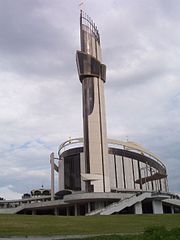 The Basilica of Divine Mercy, Krakow, Łagiewniki
The Basilica of Divine Mercy, Krakow, Łagiewniki
Before her death Faustina predicted that "there will be a war, a terrible, terrible war" and asked the nuns to pray for Poland.[31] In 1939, a year after Faustina's death when Archbishop Jałbrzykowski noticed that her predictions about the war had taken place, he allowed public access to the Divine Mercy image which resulted in large crowds that led to the spread of the Divine Mercy devotion.[31] The Divine Mercy devotion became a source of strength and inspiration for many people in Poland.[7] By 1941 the devotion had reached the United States and millions of copies of Divine Mercy prayer cards were printed and distributed worldwide.[7]
In 1942 Jałbrzykowski was arrested by the Nazis, but Father Sopocko and other professors went into hiding near Vilnius for about two years. During that period Sopocko used his time to establish a new religious congregation based on the Divine Mercy messages reported by Faustina.[32] After the War, Sopocko wrote the constitution for the congregation and helped the formation of what is now the Congregation of the Sisters of the Divine Mercy.[32] By 1951, thirteen years after Faustina's death there were 150 Divine Mercy centers in Poland.[31]
After the death of St. Faustina, the nuns at her convent sent her writings to the Vatican. Prior to 1966, any reported visions of Jesus and Mary required approval from the Holy See before they could be released to the public.[33] After a failed attempt to persuade Pope Pius XII to sign a condemnation, Cardinal Alfredo Ottaviani at the Holy Office included her works on a list he submitted to the newly elected Pope John XXIII in 1959.[34] The Pope signed the decree that placed her work on the Index of Forbidden Books and they remained on the Index until it was abolished on 14 June 1966 by Pope Paul VI. In 1959, as the Vatican forbade the Divine Mercy devotion, it also severely reprimanded Sopocko, and all his work was suppressed. However, Eugeniusz Baziak, the archbishop of Kraków, permitted the nuns to leave the original picture hanging in their chapel so that those who wished to continue to pray before it could do so.[35][2][31]
An article in the National Catholic Reporter suggested that the ban stemmed from theological issues, for example that "Jesus had promised a complete remission of sin for certain devotional acts that only the sacraments can offer, and what Vatican evaluators felt to be an excessive focus on Faustina herself ran contrary to the views at the Holy Office".[36][37]
In 1965 Karol Wojtyla, then Archbishop of Krakow and later Pope John Paul II opened a new investigation, interviewed witnesses and in 1967 submitted a number of documents about Faustina to the Vatican, requesting the start of the process of her beatification. The case was accepted for review in 1968.[31]
Acceptance and sainthood
See also: Divine Mercy Sunday Divine Mercy Sunday, May 1, 2011, at the Vatican
Divine Mercy Sunday, May 1, 2011, at the Vatican
“ Indeed the message [St. Faustina] brought is the appropriate and incisive answer that God wanted to offer to the questions and expectations of human beings in our time, marked by terrible tragedies. ” —Pope John Paul II -Divine Mercy Sunday Homily,Sunday, 22 April 2001
In 1977, over a year before he was elected as John Paul II, Archbishop Wojtyla asked the Vatican to review and lift the ban on the Divine Mercy devotion, and the ban ended in 1978.[31] In April 1978, the Prefect of the Sacred Congregation for the Doctrine of the Faith declared that the Notification ban was no longer binding, and stated that misunderstandings were created by a faulty Italian translation of Kowalska's Diary. Afterward, the questionable material could not be correlated with the original because of difficulties in communication throughout World War II and the subsequent Communist era.
The formal beatification of Faustina involved the case of Maureen Digan of Massachusetts.[38] In March 1981 Digan reported a healing, while praying at the tomb of Faustina.[2] Digan had suffered from Lymphedema (a disease which causes significant swelling due to fluid retention) for decades, and had undergone 10 operations, including a leg amputation.[39] Digan reported that while praying at Faustina's tomb, she heard a voice saying "ask for my help and I will help you" and her constant pain stopped. After 2 days Digan reported that her shoe became too large for her because her body stopped undue liquid retention.[39] Upon her return to the United States, five Boston area physicians stated that she was healed (with no explanation), and the case was declared miraculous by the Vatican in 1992 based on the additional testimony of over twenty witnesses about her prior condition.[39][2]
Faustina was beatified on April 18, 1993 and canonized on April 30, 2000 - the first saint in the 21st century. Divine Mercy Sunday is celebrated the Second Sunday of Easter (which is the first Sunday after Easter). The fact that her Vatican biography directly quotes some of her conversations with Jesus distinguishes her among the many reported visions of Jesus and Mary. Author Benedict Groeschel considers a modest estimate of the following of the Divine Mercy devotion in 2010 to be over one hundred million Catholics.[6]
See also
References
A series of articles on
Christian mysticism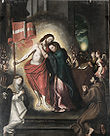
Articles
Aspects of meditation • Christian meditation • Contemplative prayer • Hesychasm • Mystical theology • Reflection on the New AgeEarly period
Gregory of Nyssa • Bernard of Clairvaux • Guigo II13th and 14th centuries
Francis of Assisi • Dominic de Guzmán • Bonaventure • Catherine of Siena15th and 16th centuries
Ignatius of Loyola • Francisco de Osuna • John of Avila • Teresa of Avila • John of the Cross17th and 18th centuries
Francis de Sales • Pierre de Bérulle19th century
Therese of Lisieux • Gemma Galgani • Conchita de Armida20th century
Maria Valtorta • Faustina Kowalska • Thomas Merton- Diary: Divine Mercy in My Soul by Faustina Kowalska 2003 ISBN 1596141107 (online version)
- Vatican biography of Faustina Kowalska
Notes
- ^ Alban Butler and Paul Burns, 2005, Butler's Lives of the Saints, Burns and Oats ISBN 0860123839 page 251
- ^ a b c d e f g h i j Tim Drake, 2002, Saints of the Jubilee, ISBN 9781403310095 pages 85-95
- ^ a b c d Vatican web site: Biography of Faustina Kowalska
- ^ a b c d Faustina: The Apostle of Divine Mercy by Catherine M. Odell 1998 ISBN 0879739231 pages 102-103
- ^ a b c d e f g h i j k l Catherine M. Odell, 1998, Faustina: Apostle of Divine Mercy OSV Press ISBN 9780879739232 pages 191-192
- ^ a b Am With You Always by Benedict Groeschel 2010 ISBN 9781586172572 page 548
- ^ a b c d e f g h i j k l m Tim Drake, 2002, Saints of the Jubilee, Authorhouse ISBN 9781403310095 pages 85-95
- ^ a b c d The encyclopedia of saints by Rosemary Guiley ISBN 9780816041343 pages 106-107
- ^ Faustina: Apostle of Divine Mercy Catherine M. Odell, 1998, ISBN 9780879739232 page 14
- ^ The encyclopedia of saints by Rosemary Guiley 2001 ISBN 0816041342 page 106
- ^ a b c d e Catherine M. Odell, 1998, Faustina: Apostle of Divine Mercy OSV Press ISBN 9780879739232 pages 36-41
- ^ a b c A Divine Mercy Resource by Richard Torretto 2010 ISBN 1450232361 pages 3-17
- ^ a b c d A Divine Mercy Resource by Richard Torretto 2010 ISBN 1450232361 "The Image of Divine Mercy" pages 84-107
- ^ Catherine M. Odell, 1998, Faustina: Apostle of Divine Mercy OSV Press ISBN 9780879739232 pages 63-64
- ^ a b c Tim Drake, 2002, Saints of the Jubilee, ISBN 9781403310095 pages 89-90
- ^ a b c Ann Ball, 2003 Encyclopedia of Catholic Devotions and Practices ISBN 0-87973-910-X pages 174-175
- ^ Catherine M. Odell, 1998, Faustina: Apostle of Divine Mercy OSV Press ISBN 9780879739232 pages 65-75
- ^ Faustina: The Apostle of Divine Mercy by Catherine M. Odell 1998 ISBN 0879739231 page 66
- ^ a b c d e f g Catherine M. Odell, 1998, Faustina: Apostle of Divine Mercy ISBN 9780879739232 pages 82-95
- ^ Great Women of Faith by Sue Stanton 2003 ISBN 9780809141234 page 30
- ^ New Catholic encyclopedia: jubilee volume, the Wojtyła years by Berard L. Marthaler, Richard E.McCarron and Gregory F. LaNave 2000 ISBN 078764787X page 528
- ^ a b c d e f g h A Divine Mercy Resource by Richard Torretto 2010 ISBN 1450232361 page 16
- ^ Butler's lives of the saints: the third millennium by Paul Burns, Alban Butler 2001 ISBN 9780860123835 page 252
- ^ Odell 156
- ^ Miravalle, Mark Introduction to Mary 1993, ISBN 9781882972067, page 122
- ^ Chaplet of Divine Mercy
- ^ a b A Divine Mercy Resource by Richard Torretto 2010 ISBN 1450232361 pages 63-79
- ^ EWTN on the Chaplet of Divine Mercy
- ^ Faustina: The Apostle of Divine Mercy by Catherine M. Odell 1998 ISBN 0879739231 pages 103-119
- ^ Faustina: The Apostle of Divine Mercy by Catherine M. Odell 1998 ISBN 0879739231 page 119
- ^ a b c d e f Catherine M. Odell, 1998, Faustina: Apostle of Divine Mercy OSV Press ISBN 9780879739232 page 153-160
- ^ a b Vatican biography of Michael Sopocko
- ^ Acta Apostolicae Sedis: No. 58/16, October 14, 1966
- ^ Dating the Shroud
- ^ An Anthology of Christian mysticism by Harvey D. Egan 1991 ISBN 0814660126 pages
- ^ Allen, John (2002-08-30). "A Saint despite the Vatican". National Catholic Reporter. http://natcath.org/NCR_Online/archives2/2002c/083002/083002f.htm.
- ^ Allen, John (2002-08-30). "A Saint despite the Vatican". National Catholic Reporter. http://findarticles.com/p/articles/mi_m1141/is_37_38/ai_91210086. (an alternate location)
- ^ Judy Roberts, Legatus magazine, May 1, 2010 [1]
- ^ a b c Catherine M. Odell, 1998, Faustina: Apostle of Divine Mercy OSV Press ISBN 9780879739232 pages 159-160
Further reading
- Pope Benedict's Divine Mercy Mandate by David Came 2009 ISBN 9781596142039
External links
- Homily of Pope John Paul
- Vatican Page on Saint Faustina
- Polish Divine Mercy Shrines
- Devotional organizations
Categories:- 1905 births
- 1938 deaths
- Polish religious leaders
- Polish saints
- Polish Roman Catholic saints
- Polish Roman Catholic nuns
- Female saints
- Visions of Jesus and Mary
- Christian mystics
- 20th-century Christian saints
- 20th-century Christian female saints
Wikimedia Foundation. 2010.

